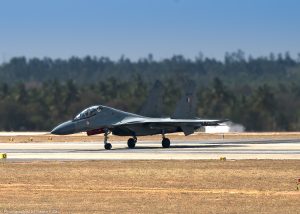Soon after Narendra Modi assumed office as India’s prime minister for the first time in 2014, his government announced an ambitious plan to “Make in India”, a set of initiatives that were to transform the country into a global manufacturing hub, rejuvenating its flagging economic growth and generating much-needed jobs. Six years later, “Make in India” was on life support. It turned out that global investors and companies wanted more than persuasive speeches and flashy ads – better infrastructure and serious reforms of the factor markets, for a start.
Modi’s initiative was also supposed to have boosted indigenous defense manufacturing. Between 2015-19, India was the world’s second largest weapons importer (falling into the number-two spot after a decade) depending on Russia, United States, France as well as Israel, for vital platforms and weapons ranging from stealth frigates and combat aircraft to brass tack items such as anti-tank guided missiles and even assault rifles.
Precisely why this is the case is a long and depressing story, the upshots being path dependence on certain platforms, poor performance by the military-technical laboratories, preference for state-run behemoths over private-sector players, bureaucratic obstacles and – this is important – a general predilection for weapons with unnecessary specs on the part of the armed services.
Following the economic hit from the COVID-19 pandemic, “Make in India” is back, buttressed by a “Vocal for Local” slogan Modi introduced during a June 11 speech. And as a corollary, so is a rhetorical commitment to indigenous defense production. As an apparent demonstration that the government meant business this time around, on August 10 the Ministry of Finance announced a”negative imports list.” It consists of 101 military items the armed forces are banned from importing beyond specified time horizons. The move has received mixed reviews.
Announcing the decision, Finance Minister Nirmala Sitharaman was clear that the government would allow imports of “some high tech [defense] equipment,” in other words, basically anything India is unable to produce domestically. But even in a world where the country did possess the requisite technological know-how, capital, as well as a smooth bureaucratic apparatus – all quite distant and elusive goals — India will still find it difficult to reduce its military imports to zero.
The reason behind this has to do with geopolitics and India’s careful foreign-policy balancing act.
Consider India’s dependence on Russian weaponry. In a recent study, the Stimson Center’s Sameer Lalwani and others have shown that 86 percent of all weapons, equipment and platforms currently deployed by India have originated in Russia. Moscow remains India’s largest source of weapons, ranging from an aircraft carrier and nuclear-powered submarine to anti-aircraft weapon systems and main battle tanks. In 2019 alone, India placed defense orders worth $14.5 billion from Russia. This is big money for Russia, especially as prices of energy commodities (its other big import) continue to slump.
The arms purchases have worked well for India, politically. It knows that large volume defense imports are a good way to keep Russia – and an increasingly unpredictable Vladimir Putin – happy. A Russia over which India has no leverage commercially is also more likely to tilt towards China. This is especially so given that the U.S.-India strategic relationship stands to potentially antagonize Moscow and has already irked Beijing.
Plainly put, behind all the talk of political solidarity between India and Russia lies cold give-and-take. And by many accounts, keeping Russia on its side (or at least neutral) in event of India’s tussle with China seems to be paying. Witness, as example, Russia’s discreet mediation in the ongoing crisis in eastern Ladakh.
But the flip side to this is that India would also have to simultaneously keep the United States placated, especially with a transactional administration such as Donald Trump’s with whom it has repeatedly clashed over trade and visas. During his visit to India in February this year, India announced its decision to buy $3 billion worth of American weapons. Trump himself sounded like an excited arms salesperson, exclaiming at a rally during his visit: “We make the greatest weapons ever made. Airplanes. Missiles. Rockets. Ships. We make the best and we’re dealing now with India.”
A similar dynamic operates when it comes to India’s arms purchases from Israel. Part of the reason why New Delhi has been able to keep Tel Aviv/Jerusalem on its side despite its bonhomie with Riyadh as well as Tehran is because, over the years, defense sales with Israel has grown to become the defining element of the relationship between the two countries. Between 2014-19, 45 percent of Israel’s total defense exports were to India, the largest market for its lucrative defense manufacturers.
India’s arms imports are inextricably linked with its geopolitical tightrope act.

































